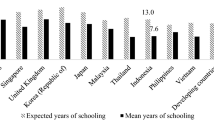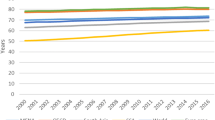Abstract
Modern economic growth theory has emphasized on the human capital effects on economic growth. In this case, the externalities from a better education could enhance economic growth process and facilitate the progress in different regional areas. The main objective of this paper is to analyze the effects of human capital on economic growth process by taking into account the case of Spanish regions. The authors examine whether a better education process and social capital can improve the economic growth process in such area and if it can explain the differences in per capita GDP existing in those regions. The paper uses data from Spanish Statistical Institute and from different institutes of the European Union.
Similar content being viewed by others
References
Abramovitz, M. “Catching Up, Forging Ahead, and Falling Behind,”Journal of Economic History, 46, 2, June 1986, pp. 385–406.
——. “Following and Leading” in Hanusch, H. ed.,Evolutionary Economics. Applications of Schumpeter's ideas, Cambridge: Cambridge University Press, 1988, pp. 323–41.
Arrow, K. J. “High Education as a Filter,”Journal of Public Economics, 3, 1973.
Barro, R. J. “Economic growth in a Cross Section of Countries,”Quarterly Journal of Economics, 106, May 1991, pp. 407–43.
——.Determinants of Economic Growth, The MIT Press, Cambridge, Masachusetts, 1997.
——. “Crecimiento Económico Por Países,”Clm. Economía, 2, 2003, pp. 11–34.
Barro, R. J.; Lee, J. “Sources of Economic Growth,” Carnegie-Rochester Conference Series on Public Policy, 40, 1994, pp. 1–46.
Baumol, W. J. “Productivity Growth, Convergence, and Welfare: What the Long-Run Data-Show,”American Economic Review, 76, 5, 1986, pp. 1072–85.
Benhabid, J.; Spiegel, M. M. “The Role of Human Capital in Economic Development. Evidence From Aggregate Cross-Country Data,”Journal of Monetary Economics, 34, 1994, pp. 143–73.
Bernard, A. B.; Jones, C. I. “Productivity Across Industries and Countries: Time Series Theory and Evidence,”The Review of Economic and Statistics, 1, February, 1996a, pp. 135–46.
Bernard, A. B.; Jones, C. I., “Technology and Convergence,”The Economic Journal, 106, July 1996b, pp. 1037–44.
Bernard, A. B.; Jones, C. I., “Comparing Apples to Oranges: Productivity Convergence and Measurement Across Industries and Countries,”American Economic Review, 86, 5, 1996c, pp. 1216–38.
Bhagwati, J, “Education, Class Structure, and Income Inequality,”World Development, 1, May 1973.
Dowrick, S.; Nguyen, D. T. “OECD Comparative Economic Growth 1950–1985: Catch-Up and Convergence,”American Economic Review, 70, 5, December 1989, pp. 1010–31.
Escot, L.; Galindo, M. “Fiscal Policy Effects, Convergence, and Growth,”International Advances in Economic Research, 5, 1, February, 1999, pp. 48–55.
Fagerberg, J. “Why Growth Rates Differ,” in Dosi, G. et al.Technical Change and Economic Theory, London: Pinter, 1988, pp. 432–57.
Galindo, M.; Escot, L. “Los Efectos Del Capital Público Sobre el Crecimiento,”Hacienda Pública Española, 144, 1998, pp. 47–62.
Galor, O.; Tsiddon, D. “Technological Progress, Mobility, and Economic Growth,”American Economic Review, 87, 3, 1997, pp. 363–82.
Gomulka, S.; Sylvestrowitcz, J. D. “Imported Growth: Theory and Estimation,” in Altman, et al. eds.,On the Measurement of Factor Productivities: Theoretical Problems and Empirical Results, Göttingen, Vendenhoeck and Ruprecht, 1976.
Islam, N. “Growth Empirics: A Panel Data Approach,”Quarterly Journal of Economics, 110, 4, 1995, pp. 1127–70.
Keefer, P.; Knack, S. “Why Don't Poor Countries Match Up? A Cross-National Test of an Institutional Explanation,”Economic Inquiry, 35, July 1997, pp. 590–602.
Lucas, R. “On the Mechanics of Development Planning,”Journal of Monetary Economics, 22, 1, July 1988, pp. 3–42.
Mankiw, N. G.; Romer, D.; Weil, D. N. “A Contribution to the Empirics of Economic Growth,”Quarterly Journal of Economics, 107, May 1992, pp. 407–37.
Mulligan C. B.; Sala-I-Martín, X. “A Labor-Income Based Measure of the Value of Human Capital,”Japan and the World Economy, 9, 1997, pp. 159–91.
Nelson, R. P.; Phelps, E. S. “Investment in Humans, Technological Diffusion, and Economic Growth,”American Economic Review, 56, 2, May, pp. 69–75.
Pérez, F.; Goerlich, F. J.; Mas, M.Capitalización y Crecimiento en España y Sus Regiones 1955–1995, Fundación BBV, 1996.
Pérez, F.; Serrano L.,Capital Humano, Crecimiento Económico, y Desarrollo Regional en España (1964–1997), Fundación Bancaja, 1998.
Romer, P. M. “Endogenous Technical Change,”Journal of Political Economy, 98, 5, 1990, pp. 71–102.
Spence, M. “Job Market Signalling,”Quarterly Journal of Economics, 87, 1973.
Van Ark, B.; Crafts, N. eds,Quantitative Aspects of Post-War European Economic Growth, Cambridge: Cambridge University Press, 1996.
Verspagen, B. “A new Empirical Approach to Catching Up or Falling Behind,” inStructural Change and Economics Dynamics, 2, 1991, pp. 359–80.
Wolff, E. “Capital Formation and Productivity Convergence Over the Long Term,”American Economic Review, 81, 3, June 1991, pp. 565–79.
Author information
Authors and Affiliations
Additional information
The Castilla La Mancha Regional Government has provided financial support for the Project PDI-02-025.
Rights and permissions
About this article
Cite this article
Martín, MA.G., Herranz, A.Á. Human capital and economic growth in Spanish regions. International Advances in Economic Research 10, 257–264 (2004). https://doi.org/10.1007/BF02295138
Issue Date:
DOI: https://doi.org/10.1007/BF02295138




